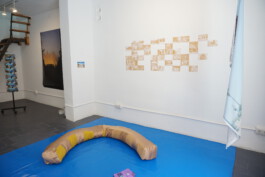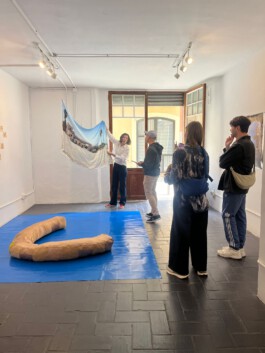
Agentes en el discurso de lugares / Actors in the Discourse of Places
Duration 07.04-05.05.2024
Artists: Sergio Monje, Marijo Ribas, and Annosh Urbanke
Curated by: Marenka Krasomil
Espai Souvenir, Barcelona
The exhibition “Actors in the Discourse of Places” deals with different views on travel, tourism and its side effects like changing neighborhoods, overtourism, weird architecture and new functions of places and sites as well as alternatives to the common and scary future scenarios.
Tourism has come under heavy criticism in light of numerous contemporary crises – ecological, social and political – and amidst demands for more sustainability and responsibility and increasing efforts to reduce carbon footprints. And yet, being a tourist is something most people do regularly, at least in the Global North. The ritual of going on vacation begins in the imagination, with the fantasies that are created by images of ‘vacation’. The places people travel to are often not chosen for their beauty, but for the promise they hold. The scenes created in the imagination before going on holiday, the trip to a place that has already been fictionalized and the affects that are configured and integrated into the staged scenario are constants in every step of the tourist ritual.
The exhibition takes the book “Actors in the Discourse of Places: A Polyphonic Travel Guide” as a starting point. The travel guide as a framework to highlight a variety of views and voices, to include spaces of dissent alongside deviations and variations of the known is serving the book as a framework. While many participants in this project focus on the region of Catalunya, it becomes clear that tourism represents an international, not a local challenge; what happens in Catalunya is also happening elsewhere.
The book was produced during a residency at Casa Planas with the support of the Goethe Institut Barcelona and contains contributions by Beatriz Escudero (in collaboration with Alán Carrasco, Zaida Trallero, Matteo Guidi, María García, Violeta Kovacsics, Eloy Fernández Porta, Pedro G. Romero, Pilar Rubí, Juan David Cortés, Ian Waelder and Irene de Andrés), Marenka Krasomil, Neus Marroig, Sergio Monje, Ivan Murray Mas, Marina Planas Antich, Marijo Ribas, Marta Torres Ruiz and Annosh Urbanke, edited by Marenka Krasomil.
Works
Sergio Monje: Todas las costas posibles (All the possible coastlines), 2022
Video installation (41", loop), images generated by artificial intelligence.
postcard prints (10 x 15 cm), postcard display. Variable dimensions
From hundreds of postcards of the Balearic coastline from the Planas Archive (which documents the period of tourist development in the islands), Monje has trained an Adversary Generative Network: an artificial intelligence tool that allows us to generate new images of non-existent coastlines. Thus, we trace alternative channels in the history of the Balearic landscape, producing a new fictitious archive, representing an imaginary and speculative archipelago.
Conmemoraciones futuras (Future Commemorations), 2024
Digital print, 22.5 x 14.5 cm,
An epilogue of Todas las costas posibles, commemorating events that have not happened yet. The postal stamps show the occupation of the airport of Palma on the day of the tourist in 2028.
Sergio Monje (Palma, 1994) is a visual artist. His work, halfway through research, has dealt with images, work or technology, to focus in recent years on the phenomenon of tourism. He graduated in Fine Arts at the Universitat de Barcelona and continued her studies in Literature, Art and Thought at the Universitat Pompeu Fabra. He has obtained grants and developed artistic projects in several art centers, such as Es Baluard Museu, Azkuna Zentroa, Etopia Centro de Arte y Tecnología, Casa Planas, Casal Solleric, Sala d'Art Jove (Barcelona), Can Felipa or MNAC. He is currently developing his first documentary feature film.
Marijo Ribas: Arco, 2024.
Textile sculpture (150x200 cm), silk fabric, postcards, and a photo.
The work Arco is part of a series that examines a specific architectural trend in Mallorca in the 1960s and 1970s: the construction of medieval-style castles. These castles were erected for a variety of purposes: restaurants, hotels, factories, workshops or skating rinks. Many of these monuments continue to attract tourists today, following the logic of the Las Vegas Strip, but with a medieval iconography.
Marijo Ribas Graduated in Fine Arts at the University of Barcelona (2006), erasmus at HfG Offenbach, Frankfurt (2005), Postgraduate in Design, Art and Society, Elisava Barcelona (2008), Master in Artistic Productions and Research, University of Barcelona (2010) and first PhD courses in Art History, University of Barcelona (2013). Since 2003 she has participated in exhibitions in spaces such as Frac Corsica, Ruse Gallery, Spazju Kreattiv Malta, MUU Kaapeli Helsinki, Círculo de Bellas Artes Madrid, Centre de Cultura Contemporanea de Barcelona, Centre d'Art Santa Mònica, LABoral Centro de Arte, Es Baluard Museu, etc. She has carried out numerous residencies in centers such as: MediaLAB Prado, Edinburgh Sculpture Workshop or Belgrade A.I.R, among others.
Annosh Urbanke: Encountering Experience - ll, 2023
5 Photographs, various sizes
The photographs of the series Encountering Experience - ll show people looking at heritage sites or posing in front of them, which started with (historically) examining Kodak’s promotion of places. Individual dreamworlds and persona's are captured as a performative dance that moves along the tourist infrastructure and its (im)possibilities. Details like plastic bottles, audio guides – the markers of city tourists – are the protagonists in Urbanke’s works and allow the images to transcend their locality.
Notes & Directions by Your Lunar Tour Guide, 2023
Audio 4:40 min, postcard (10 x 15 cm)
Notes & directions by your lunar tour guide takes a speculative lead in the experience of time and space at a heritage site. It plays with the interaction of regulations and behavior by tourists, like the fact that many people want to mark their visit by portraying themselves with their national flags.
Text and image: Annosh Urbanke. Voice actor and sound edit: Frederique Pisuisse
Annosh Urbanke works in the areas of writing, photography, curating and research in post-socialist contexts. In her artistic research she explores nostalgic and contemporary forms of tourism through a curatorial and photographic lens. While considering personal and collective experiences she looks at today‘s consumption and performative elements of tourism.
ESPAÑOL_________________________________________
La exposición Agentes en el discurso de lugares aborda diferentes perspectivas sobre los viajes, el turismo y los fenómenos que lo acompañan, como los barrios cambiantes, el sobreturismo, la arquitectura invasiva y las nuevas funciones de lugares y sitios, así como alternativas a los aterradores escenarios futuros.
El turismo ha sido objeto de duras críticas ante las numerosas crisis actuales -medioambientales, sociales y políticas- y en medio de llamamientos a una mayor sostenibilidad y responsabilidad y de crecientes esfuerzos por reducir la huella ecológica. Y sin embargo, ser turista es algo que la mayoría de la gente hace de forma habitual, al menos en el Norte Global. El ritual de irse de vacaciones comienza en la imaginación, con las fantasías creadas por las imágenes de las "vacaciones". Los lugares a los que se viaja no suelen elegirse por su belleza, sino por la promesa que ofrecen. Las escenas que surgen en la imaginación antes de las vacaciones, el viaje a un lugar ya ficcionalizado y los afectos que se incorporan al escenario son constantes en cada paso del ritual turístico.
La exposición toma como punto de partida el libro "Agentes en el discurso de lugares: Una guía de viaje polifónica". La guía de viajes sirve de marco para poner de relieve una variedad de puntos de vista y voces, para incluir espacios de disidencia junto a desviaciones y variaciones de lo conocido. Aunque muchos artistas de este proyecto se centran en la región de Cataluña, el turismo representa un reto internacional, no local: lo que ocurre en Cataluña también ocurre en otros lugares.
El libro fue producido durante una residencia en Casa Planas con el apoyo del Goethe Institut Barcelona y contiene contribuciones de Beatriz Escudero (en colaboración con Alán Carrasco, Zaida Trallero, Matteo Guidi, María García, Violeta Kovacsics, Eloy Fernández Porta, Pedro G. Romero, Pilar Rubí, Juan David Cortés, Ian Waelder y Irene de Andrés), Marenka Krasomil, Neus Marroig, Sergio Monje, Ivan Murray Mas, Marina Planas Antich, Marijo Ribas, Marta Torres Ruiz y Annosh Urbanke, editado por Marenka Krasomil.





